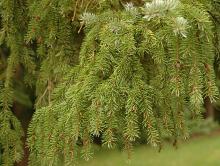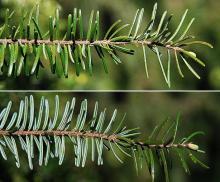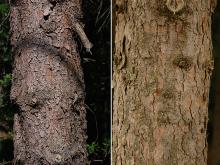Picea omorika
Common name:
Serbian Spruce
Pronunciation:
PI-see-a o-mor-E-ka
Family:
Pinaceae
Genus:
Type:
Conifer
Native to (or naturalized in) Oregon:
No
- Conifer, evergreen tree, to 60ft (18 m) tall, with a spread of 20-25 ft (6.7.6 m), very slender trunk, forms a narrow, pyramidal head. Bark coffee color, with thin scales. Needles short, 13-25 mm long, flat (most spruce needles are 4-sided), keeled on both sides, dark green without stomata above, glaucous white with 4-6 distinct, stomatic bands on either side of the midrib below. Cones oblong-ovoid 3-4.5 cm long, 1.3-2 cm in diameter, glossy cinnamon brown when ripe.
- Sun. Best in a deep rich soil, moist and well-drained. Appears to tolerate city conditions.
- Hardy to USDA Zone 4 This species was discovered in 1875 by Josif Pancic (1814-188) in southwestern Serbia and thought to be limied to a few stands in the Tara and Javor mountains on either side of the upper Drina River. More recent studies have shown that Serbian spruce is also present in Bosnia and Herzegovina (Dalibor Ballian, Univ. Sarajevo, 2018).
-
A few cultivars are in the nursery trade:
- 'Bruns' - tree, very narrow, 14 ft (4 m) tall and 4 ft (1.2 m) wide in 10 years, foliage light green and light blue
- 'Pendula' - tree, narrow, weeping branches
- 'Pendula Bruns' - tree, weeping, extremely narrow, 7ft (2.1 m) tall and 2 ft (0.6 m) wide in 10 years, foliage silvery blue-green
- 'Pimoko' - dwarf shrub, dense, thickly branched, rounded globose form
- omorika: the Balkan vernacular name for spruce (Jacobson, 1996).







